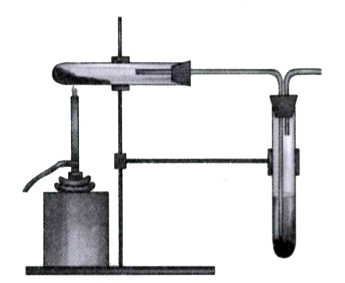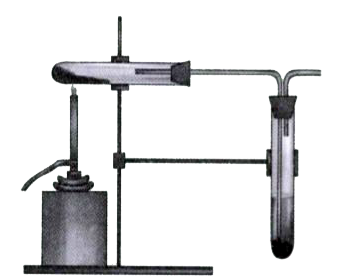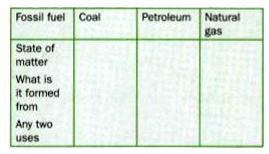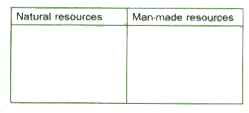Complete Solutions to CLASSROOM CORNER of chapter COAL AND PETROLEUM of Class 8 book with complete answers and questions
| Class 8 | CHEMISTRY |
| Chapter | COAL AND PETROLEUM |
| PEARSON IIT JEE FOUNDATION | CLASSROOM CORNER |
| Number Of Questions | 100 |
| Academic Year | 2023-24 |
Which of these is renewable resource?
00:51View SolutionDuring frictional distillation, which of these components of crude oil does not condense on any of the trays in the fractioning column?
01:47View SolutionWhilch of these forms of coal contains the highest amount of carbon?
00:58View SolutionWhich of these actions can contribute towards conserving fossil fuels?
02:51View SolutionWater is a ______________.
00:27View SolutionWhen coal burns in air then
01:24View SolutionPurest form of carbon is
00:54View SolutionCoal tar contains about
01:00View SolutionThe first oil well was drilled in
00:32View SolutionPCRA stands for
01:29View SolutionAn example of fossil fuel is
01:55View SolutionWhich of the following is natural resource?
00:34View SolutionWhich of the following is man made resource?
01:04View SolutionWhich of the following is obtained form coal tar?
01:27View SolutionCoal is broken down into many simpler, useful substnaces through a process called____
01:52View SolutionPetroleum is called a ______resource because it cannot be naturally replaced in the foreseeable future.
01:43View SolutionAny substance that can be burnt to produce energy is called a/an___________.
01:21View SolutionThe tall tower into which vapours of crude oil are passed during fractional distillation is called a _____________column.
01:53View SolutionThe full of CNG is ___________.
01:15View SolutionThe form of carbon that contains the lowest amount of carbon is called____________.
02:06View SolutionIncrease in the carbon dioxide levels in the atmosphere has gradually led toa phenomenon known as _______
01:27View SolutionLocations where the Earth is drilled into a bring petroleium up to the surface are called ________.
01:27View SolutionThe judicious use of fossil fuels and other energy sources is called_____of energy.
00:59View SolutionThe main constituent of natural gas is hydrocarbon called________
00:50View Solution________is used in aircraft and in vehicles such as cars and as a solvent while dry cleaning clothes.
01:12View SolutionIn the fractional distillation process, crude oil is heated to a temperature of about____in a tall furnace.
01:57View Solution________is a fuel composed mainly of nitrogen `(N_(2))` and carbon monoxide (CO), formed by passing air through red hot coke.
00:55View Solution________is used to make things such as pesticides, perfumes, naphthalene balls and paints.
01:48View Solution______________is used in the production of other fuels such as producer gas and water gas.
01:17View Solution_______of coal is a process in which coal is heated strongly at a temperature of `1000^(@)C` in the absence of air
02:14View SolutionThe process of heating coal in the absence of air is called the destructive distallation of coal. Coal contains a number of elements such as carbon, hydrogen, oxygen, nitrogen and sulphur. When coal is heated in the absence of air, a number of products are obtained. A laboratory set up to carry out destructive distillation of coal as shown.

Read the below questions and try to answer them.
Name the main products obtained by the destructive distillation of coal.01:18View SolutionThe process of heating coal in the absence of air is called the destructive distallation of coal. Coal contains a number of elements such as carbon, hydrogen, oxygen, nitrogen and sulphur. When coal is heated in the absence of air, a number of products are obtained. A laboratory set up to carry out destructive distillation of coal as shown.

Read the below questions and try to answer them.
Give two uses of coal tar.02:28View SolutionThe process of heating coal in the absence of air is called the destructive distallation of coal. Coal contains a number of elements such as carbon, hydrogen, oxygen, nitrogen and sulphur. When coal is heated in the absence of air, a number of products are obtained. A laboratory set up to carry out destructive distillation of coal as shown.

Read the below questions and try to answer them.
Explain why coal gas is considered an excellent fuel?02:58View SolutionThe process of heating coal in the absence of air is called the destructive distallation of coal. Coal contains a number of elements such as carbon, hydrogen, oxygen, nitrogen and sulphur. When coal is heated in the absence of air, a number of products are obtained. A laboratory set up to carry out destructive distillation of coal as shown.

Read the below questions and try to answer them.
Name the purest of coal.03:00View SolutionPetroleum is a complex mixture of solid liquid and gaseous hydrocarbons, mixed with salt water and earthy particles. It is always found trapped between two impervious rocks. It is believed that petroleum is formed by the anaerobic decomposition of extremely small sea animals and plants which got buried in the sea bed millions of years ago.
Read the below questions and try to answer them.
Why does petroleum has a strong foul smell?02:16View SolutionPetroleum is a complex mixture of solid liquid and gaseous hydrocarbons, mixed with salt water and earthy particles. It is always found trapped between two impervious rocks. It is believed that petroleum is formed by the anaerobic decomposition of extremely small sea animals and plants which got buried in the sea bed millions of years ago.
Read the below questions and try to answer them.
What do you understand by refining of petroleum?01:55View SolutionPetroleum is a complex mixture of solid liquid and gaseous hydrocarbons, mixed with salt water and earthy particles. It is always found trapped between two impervious rocks. It is believed that petroleum is formed by the anaerobic decomposition of extremely small sea animals and plants which got buried in the sea bed millions of years ago.
Read the below questions and try to answer them.
Name the method by which petroleum is refined.02:23View SolutionPetroleum is a complex mixture of solid liquid and gaseous hydrocarbons, mixed with salt water and earthy particles. It is always found trapped between two impervious rocks. It is believed that petroleum is formed by the anaerobic decomposition of extremely small sea animals and plants which got buried in the sea bed millions of years ago.
Read the below questions and try to answer them.
Name some by products that are obtained while refining petroleum.00:51View SolutionNatural was formed millions of years ago along with petroleum when microscopic sea plants and animals died and got buried under the sand and mud. These plants & animals under anaerobic conditions changed to gas. Natural gas consist mainly of methane (about 85%), ethane (about 10%) propane (about 3%) and butane. Read the below questions and try to answer them.
Why CNG being used as fuel for transportation?02:04View SolutionNatural was formed millions of years ago along with petroleum when microscopic sea plants and animals died and got buried under the sand and mud. These plants & animals under anaerobic conditions changed to gas. Natural gas consist mainly of methane (about 85%), ethane (about 10%) propane (about 3%) and butane. Read the below questions and try to answer them.
Name two uses of natural gas.02:05View SolutionNatural was formed millions of years ago along with petroleum when microscopic sea plants and animals died and got buried under the sand and mud. These plants & animals under anaerobic conditions changed to gas. Natural gas consist mainly of methane (about 85%), ethane (about 10%) propane (about 3%) and butane. Read the below questions and try to answer them.
Name one advantage of CNG.03:20View SolutionNatural was formed millions of years ago along with petroleum when microscopic sea plants and animals died and got buried under the sand and mud. These plants & animals under anaerobic conditions changed to gas. Natural gas consist mainly of methane (about 85%), ethane (about 10%) propane (about 3%) and butane. Read the below questions and try to answer them.
Where does natural gas reservoir found in our contry?02:12View SolutionWhat do you understand by calorific value of a fuel?
01:03View SolutionGive two characteristics features of an ideal fuel.
02:32View SolutionCan we use all our natural resources forever?
01:35View SolutionCan air, water and soil be exhausted by human activities?
01:20View SolutionIs water a limit less source?
01:18View SolutionName the petroleum product used for surfacing of roads.
00:53View SolutionExplain why fossil fuels are exhaustible natural resources
02:56View SolutionAssertion: Anthracite is the purest form of coal.
Reason: It contains about 50% of carbon.01:51View SolutionAssertion : CNG and LPG are clean fuels.
Reason : They do not leave any residue on burning.01:41View SolutionAssertion : Petrol is more volatile than diesel oil.
Reason : Petrol codneses near the top of the column than diesel oil.03:04View SolutionAssertion: Charcoal does not produce any smoke.
Reason: Charcoal contains only carbon.02:50View SolutionAssertion : Kerosene is a fossil fuel.
Reason : Kerosene is not obtained as a fraction of fractional distillation of petroleum.01:31View SolutionGive reasons for each of the following:
A foul smelling chemical is added to natural gas before distributing it to homes and factories.02:17View SolutionGive reasons for each of the following:
Coal, petroleum and natural gas are called fossil fuels.02:18View SolutionGive reasons for each of the following:
Natural gas is always found about petroleum deposits inside impervious rocks.01:15View SolutionComplete the table given below with information about fossil fuels.
 04:10View Solution
04:10View SolutionWrite any two points of difference between renewable and non renewable resources.
03:18View SolutionDescribe how petroleum is formed from the remains of marine plants and animals over a period of millions of year? Explain in brief.
03:06View SolutionMention any three things we can do in our day to day lives to help conserve fossil fuels.
03:32View SolutionHow do fossil fuels contribute to pollution? Commet.
01:41View SolutionDuring fractional distillation of petroleum, different components condense at different heights in the fractionating tower. Explain why?
02:51View SolutionExplain these points given below.
Coke is sometimes perferred over coal as a fuel.02:15View SolutionExplain these points given below.
Increase in carbon dioxide content in te atmosphere has led to global warming.02:29View SolutionExplain these points given below.
The process of formation of coal inside the Earth is called carbonization.01:45View SolutionWhat are the advantages of using CNG and LPG as fuels? Give three points.
02:30View SolutionDescribe how coal is formed from dead vegetation. What is this process called?
03:00View SolutionHow do oil spills harm the environment? Comment.
03:10View SolutionHow does acid rain cause soil infertility? Justify Your answer.
01:53View SolutionExplain how global warming does melt the polar ice caps.
04:07View SolutionDo you think it is justified to call coal, crude oil and natural gas non renewable resources? Give reasons to support your answer.
02:10View SolutionWhich fossil fuel is an environment friendly fuel? Describe how it has been used in recent years in an effort to reduce pollution levels caused due to burning of fossils fuels?
02:48View SolutionState few advises given by PCRA for saving petrol and diesel. Explain them in your own words.
03:17View SolutionWhat are petrolcheimicals? Give two classes of petrochemicals.
02:07View SolutionHow will renewable energy helps to restore the environment?
02:24View SolutionWhat is the imporance of energy conservation?
02:13View SolutionWhat do you understand by reservoir rock?
02:29View SolutionExplain why the layer of petroleum is above the water.
01:45View SolutionExplain why is coal known as black diamond?
02:02View SolutionExplain why water is an inexhaustible natural resources. Comment.
03:02View SolutionWhy is renewable energy important for our future?
02:13View SolutionGive reasons for the below points.
What are inexhaustible natural resources give two examples?02:04View SolutionGive reasons for the below points.
Why reneble energy is important?01:51View SolutionGive reasons for the below points.
Can renewable energy replace fossil fuels?01:28View SolutionDo you think there will be any impact on human life coal supplies get exhausted in next 5 years?
02:14View SolutionExplain what will happen if petrol gets exhausted.
02:03View SolutionWhere is the India's largest Strategic Petroleum Reserve is located?
01:28View SolutionHow do you think renewable resources such as sunlight and water can contribute twoards conserving fossils fuels?
03:49View SolutionIt has been estimated that coal and petroleum reserves will last another hundred years.
a. What are the reasons that have led to this condition of natural resources?
b.Do you think survical of human beings would be possible? Support your answer with reasons.View SolutionThe roots of all resources, both natural and man made, lie in nature. Justify this statement with appropriate reasons and /or examples.
View SolutionSort the things listed below into natural and man made resources.

b. On the basis of your classification, define the term resource.
b. How can be conserve natural resources.
c. give two uses of coal.
e. How coal in majority formed?View SolutionWhat do you understand by destructive distillation of coal? Draw a neat and labelled dia gram showing the laboratory set up for the destructive distillation of coal.
03:19View SolutionExplain how the vapours of crude oil rising up in the fractioning column of a fractional distillation set up are separated into different components.
View SolutionBriefly describe the term given below:
Lignite01:38View SolutionBriefly describe the term given below:
Anthracite02:04View SolutionBriefly describe the term given below:
Producer gas00:39View SolutionBriefly describe the term given below:
Coke01:47View SolutionBriefly describe the term given below:
Natural gas02:13View SolutionExplain how coal is formed from the remains of dead plants and trees over millions of years. Justify your answer.
03:05View Solution
CLASSROOM CORNER questions and complete solutions for chapter COAL AND PETROLEUM of PEARSON IIT JEE FOUNDATION of Class 8
